Queens of the highway
Wednesday, September 01, 2004
Last year a Bahraini friend of mine had to go on a one-day business trip to Karachi. It was his first time visiting Pakistan. When he came back I asked him how his trip was.
"It was great!" he said. "I think there was a festival going on in the city that day."
"Really?" I responded. "Why, what was going on?"
"Well all of the buses and trucks were decorated and painted with really bright colours and images."
"Ha ha," I laughed, "in Pakistan every day is a festival."
That's right. What my friend had been describing was not specific to that day. One of the most bizarre aspects about Pakistan are the intricately decorated vehicles churning out clouds of black smoke as they traverse the country's roads and highways.
The story goes that sixty odd years ago, just prior to the partition of India and Pakistan, there was a Muslim painter who was an employee in the Court of a princely state in the region of Kutch. After partition, the princely state was incorporated in to India, so the painter found himself with no patrons, unemployed. So he migrated to Karachi in search of better prospects. But even here the best work he could find was to paint the names of companies on carts and trucks. At first he just painted the letters of the company name, but given his artistic inclinations he started adding minor ornamental embellishments. Gradually, these embellishments became more and more elaborate. This idea caught on throughout the country to the point where today there are no heavy vehicles on the streets which are not densely covered in brightly coloured decorations, cultural and religious symbols, verses of poetry, valley sceneries, woodwork, metalwork, "chamak-patti", and much more. Even the insides are heavily decorated. In the nearly 60 years since this medium started there have developed several distinct regional and stylistic schools of vehicle art, each with its own "Master".
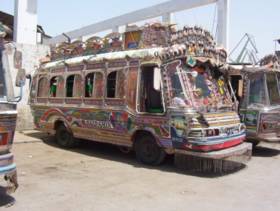
This phenomenon fits in nicely into the theoretical frameworks of "Islamic art" already available to us today. Orthodox Islam has generally frowned upon the imagery of humans and animals. Thus, in most muslims cultures arts like calligraphy and architecture have usually excelled. The general criteria, as it seems to be, is that the medium should serve, primarily, a functional purpose. The medium could then be given an aesthetic wrapping with ornamental embellishments. For example, the primary role of calligraphy is to records verses of the Qur'an, or to send messages. The primary function of architecture is to serve as shelter or a place of prayer, etc. In practice however, very often the aesthetic role would overtake the functional role as the artists manipulated the medium to vent the artistic desires.
When Pakistan was created, with a supposed Islamic/Muslim agenda, little public space was given to people calling themselves artists, as it was something frowned upon. Artists, who had formerly been patronized by Princes to paint pictures of the royal family, were now unable to carry forward their tradition. It seems almost natural that in such a context vehicles would be the next medium of choice for these artists. For vehicles have the obvious functional role of transport, and they also provide a large and interesting canvas upon which one can explore aesthetics. In the way that Trinidadians created the steel pans to carry on their African musical traditions that the British had denied, the creation of Pakistani vehicle art is a very similar phenomenon.
For many Pakistanis and non-Pakistanis alike, the country's vehicle art is far too gaudy to be appreciated. It is an acquired taste. But if you spend some time examining everything that's going on, there is a chance you might see some depth to it. Most of the symbolism refers to religion (like the Ka'ba, or Buraq), to nationalism (like a flag, or a PIA airliner), and to traditional culture (like the Taj Mahal or a valley scenery). But every so often I come across something so bizarre that I have no idea how to interpret it. For example, have a look at the picture below of a bus:
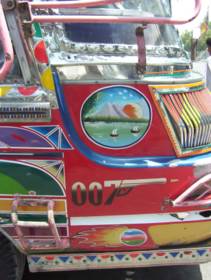
Here you see a lake scenery, below which is a James Bond "007" revolver, below which is what looks to be a rocket-propelled multicolor cricket ball. On my next trip to Karachi I will be sure to locate the artist and ask him for a puff of whatever he's been smoking.
Below are a few more examples of vehicle art. You can see many more pics in my webshots albums (Buses, Trucks, Misc), and some more elaborate ones on Jamal Elias's On Wings of Diesel site.
The tank of a water tanker:
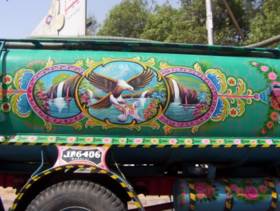
A bus interior:
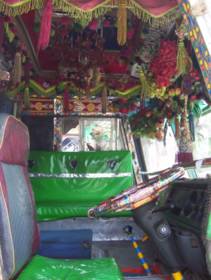
A detail of the bus interior showing a bizarre Pakistani "love" boat:
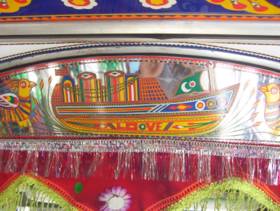
0 Responses to 'Queens of the highway'
Leave a Reply:
» To leave new comments, please go to the new address of this page.